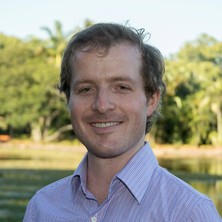
Overview
Background
Dr. Matthew Holden is an applied mathematician using modelling to improve environmental outcomes. Mathematical tools unify his research across several diverse topics in biodiversity conservation, theoretical ecology, fisheries, and other branches of natural resource management. He is especially interested in how we improve the well-being of human populations at least cost to biodiversity.
Dr. Holden currently serves as the Vice President of the Resource Modeling Association, an international society of economists, mathematicians, and envrionmental scientists unified via their passion for modelling and other quantitative methods to solve the world's hardest natural resource management problems. He also is the Deputy Director of Research for the Centre for Biodiversity and Conservation Science (CBCS), and is also affiliated with the Centre for Marine Science (CMS).
Dr. Holden was awarded his Ph.D. in Applied Mathematics at Cornell University, where he used dynamical systems, optimal control, and statistical theory to recommend policies to improve the management of invasive species, agricultural pests, and fisheries. He received his bachelor’s degree from the University of California, Davis, where he won the University Medal, working on the effect of habitat fragmentation on the persistence of endangered species.
Availability
- Dr Matthew Holden is:
- Available for supervision
- Media expert
Fields of research
Qualifications
- Doctoral Diploma, Cornell University
Supervision
Availability
- Dr Matthew Holden is:
- Available for supervision
Before you email them, read our advice on how to contact a supervisor.
Available projects
-
More Parks or Better Parks? Modeling Optimal Conservation Policies for Biodiversity
How can we make the most of limited conservation budgets to protect endangered species? This project investigates the optimal balance between expanding protected areas—such as national parks—and improving the management of existing ones. With ambitious new international targets calling for at least 30% of Earth’s surface to be conserved, it is crucial to determine whether more land protection or better stewardship offers the greatest ecological return. Through a combination of dynamical systems modelling, optimisation techniques, and real-world data, this project will develop and analyse models to inform smarter conservation policies. Students will explore interdisciplinary questions at the intersection of mathematics, ecology, and policy, with the opportunity to contribute to impactful environmental decision-making.
-
Improving Sustainable Agriculture Through Insect Movement Models
Are you interested in applying mathematics to real-world ecological and agricultural challenges? This project explores the use of mathematical modeling to improve sustainable pest management in farming. Trap cropping—a technique that uses attractive "decoy" plants to divert pests from valuable crops—has shown promise in small-scale settings like greenhouses, but often fails at commercial scales. We aim to understand why, using tools such as ODEs, Difference Equations, Markov Processes, and Simulations to model pest movement and behavior. By combining theory with practical applications, this project offers students the chance to engage in meaningful, interdisciplinary research that can contribute to more sustainable agricultural practices.
-
Accurately detecting population trends in ecology
Accurately estimating trends in population abundance is critical for developing ecological theory, performing environmental assessments, and advising natural resource management. While the error and power of statistical methods for detecting population declines and recoveries are well-studied, they rarely consider the issues of density dependence. If population size time series data occurs in an area where the species is abundant, density dependence may cause the over-prediction of a population decline. In this project, we will calculate the probability of misestimating population growth rates above or below a specified threshold. We will then use the analysis in two applied contexts (1) the probability of falsely predicting a threatened species is declining or recovering and (2) the use of linear population models for predicting species occurrence spatially. In the latter case, we will derive simple rules of thumb for the critical population abundance, in relation to carrying capacity, after which density dependence interferes with accurate predictions of persistence. The critical abundance can be used as a guideline for when it may be appropriate to use linear population process models to predict species occurrence in a density-dependent world. The outcomes of the project can inform conservation planning from reserve design to invasive and threatened species management
Supervision history
Current supervision
-
Master Philosophy
Optimal resource allocation between protected area managment and expansion
Principal Advisor
Other advisors: Associate Professor Michael Bulmer
Completed supervision
-
2024
Doctor Philosophy
On quantitative indices and modelling of harvested fish populations
Principal Advisor
Other advisors: Emeritus Professor Jerzy Filar
-
2025
Doctor Philosophy
Proximate factors of "Mushy Tuna Syndrome" in Skipjack Tuna and an Amelioration Plan for South Pacific Fishers and Processors.
Associate Advisor
Other advisors: Dr Simone Blomberg, Professor Louw Hoffman, Associate Professor Ian Tibbetts
-
2024
Doctor Philosophy
Spatial optimisation of conservation actions to minimise species threat status and population extinction risk among African mammals
Associate Advisor
Other advisors: Professor Hugh Possingham
-
2020
Doctor Philosophy
The exposure and contribution of predators and scavengers to humans
Associate Advisor
Other advisors: Professor James Watson, Professor Eve McDonald-Madden
Media
Enquiries
Contact Dr Matthew Holden directly for media enquiries about:
- environmental decision making
- math
Need help?
For help with finding experts, story ideas and media enquiries, contact our Media team:
